Sustainable Buildings Assignment B: Detailed Retrofit Proposal Report
VerifiedAdded on 2022/09/17
|17
|4740
|14
Report
AI Summary
This report presents a detailed retrofit proposal for improving the sustainability of an office building in the UAE. The study focuses on energy efficiency, reduced carbon emissions, and life cycle cost considerations. It explores both passive measures like solar shading and thermal insulation, and active measures such as HVAC system upgrades and lighting retrofits. A simulation model is used to evaluate the impact of different retrofit scenarios, considering building features and climatic conditions. The research emphasizes the importance of an integrated approach, combining passive and active measures to achieve significant energy savings and minimize reliance on grid electricity. The proposal includes technical details of the case study, the Ministry of Infrastructure Development building in Ras Al Khaimah, and analyzes the environmental and cost implications of the proposed retrofit strategies. The study validates the simulation results and discusses the potential for achieving nearly zero-energy buildings through a holistic retrofit approach.
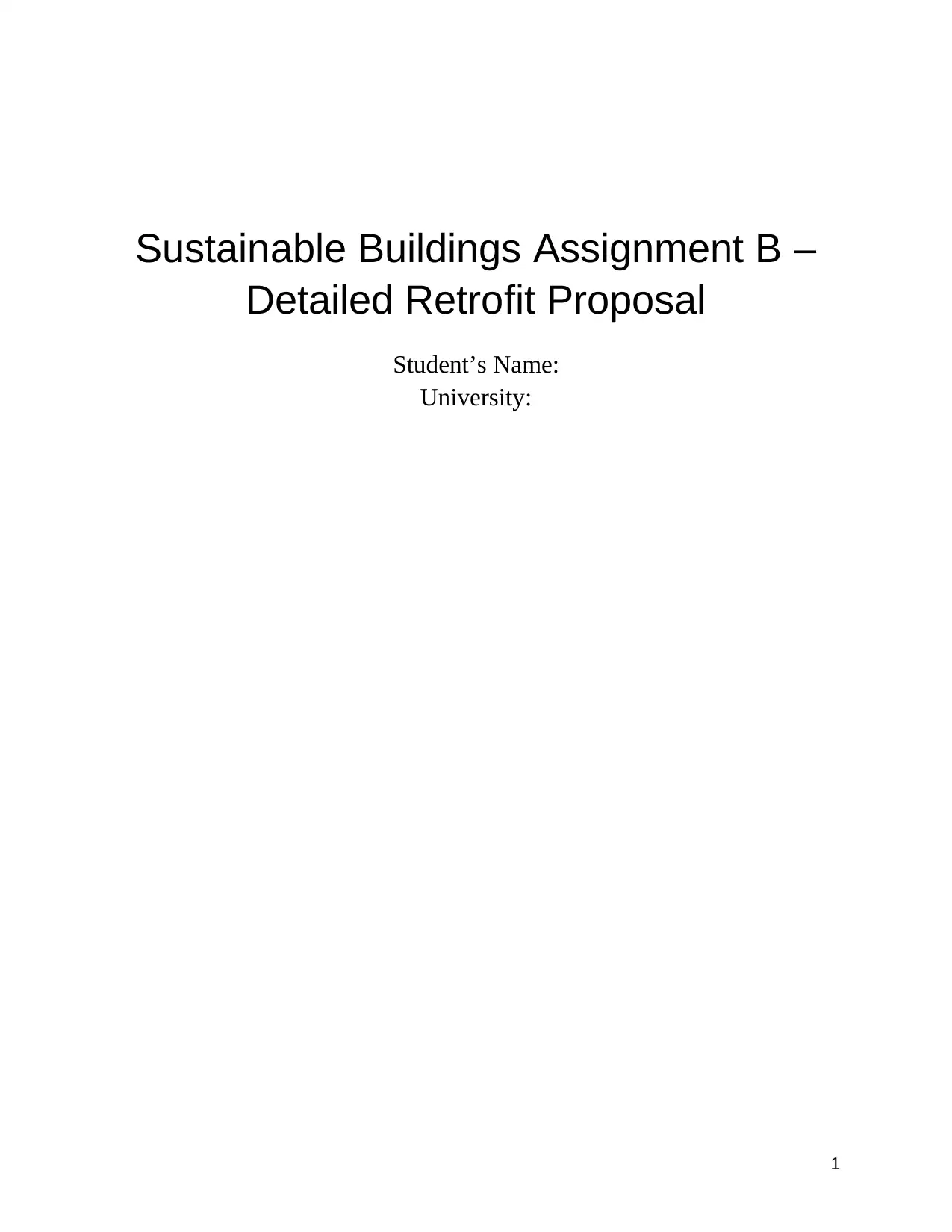
Sustainable Buildings Assignment B –
Detailed Retrofit Proposal
Student’s Name:
University:
1
Detailed Retrofit Proposal
Student’s Name:
University:
1
Paraphrase This Document
Need a fresh take? Get an instant paraphrase of this document with our AI Paraphraser
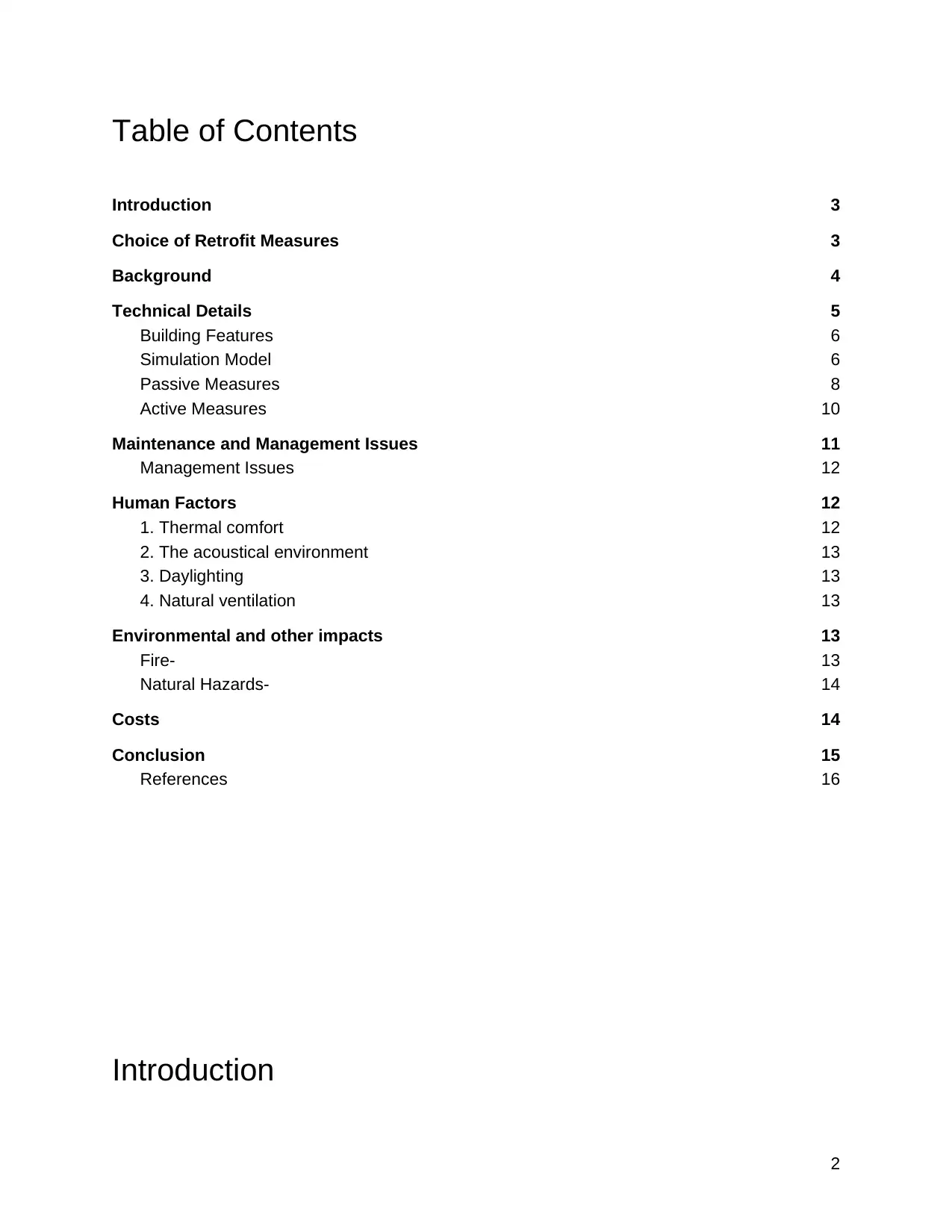
Table of Contents
Introduction 3
Choice of Retrofit Measures 3
Background 4
Technical Details 5
Building Features 6
Simulation Model 6
Passive Measures 8
Active Measures 10
Maintenance and Management Issues 11
Management Issues 12
Human Factors 12
1. Thermal comfort 12
2. The acoustical environment 13
3. Daylighting 13
4. Natural ventilation 13
Environmental and other impacts 13
Fire- 13
Natural Hazards- 14
Costs 14
Conclusion 15
References 16
Introduction
2
Introduction 3
Choice of Retrofit Measures 3
Background 4
Technical Details 5
Building Features 6
Simulation Model 6
Passive Measures 8
Active Measures 10
Maintenance and Management Issues 11
Management Issues 12
Human Factors 12
1. Thermal comfort 12
2. The acoustical environment 13
3. Daylighting 13
4. Natural ventilation 13
Environmental and other impacts 13
Fire- 13
Natural Hazards- 14
Costs 14
Conclusion 15
References 16
Introduction
2
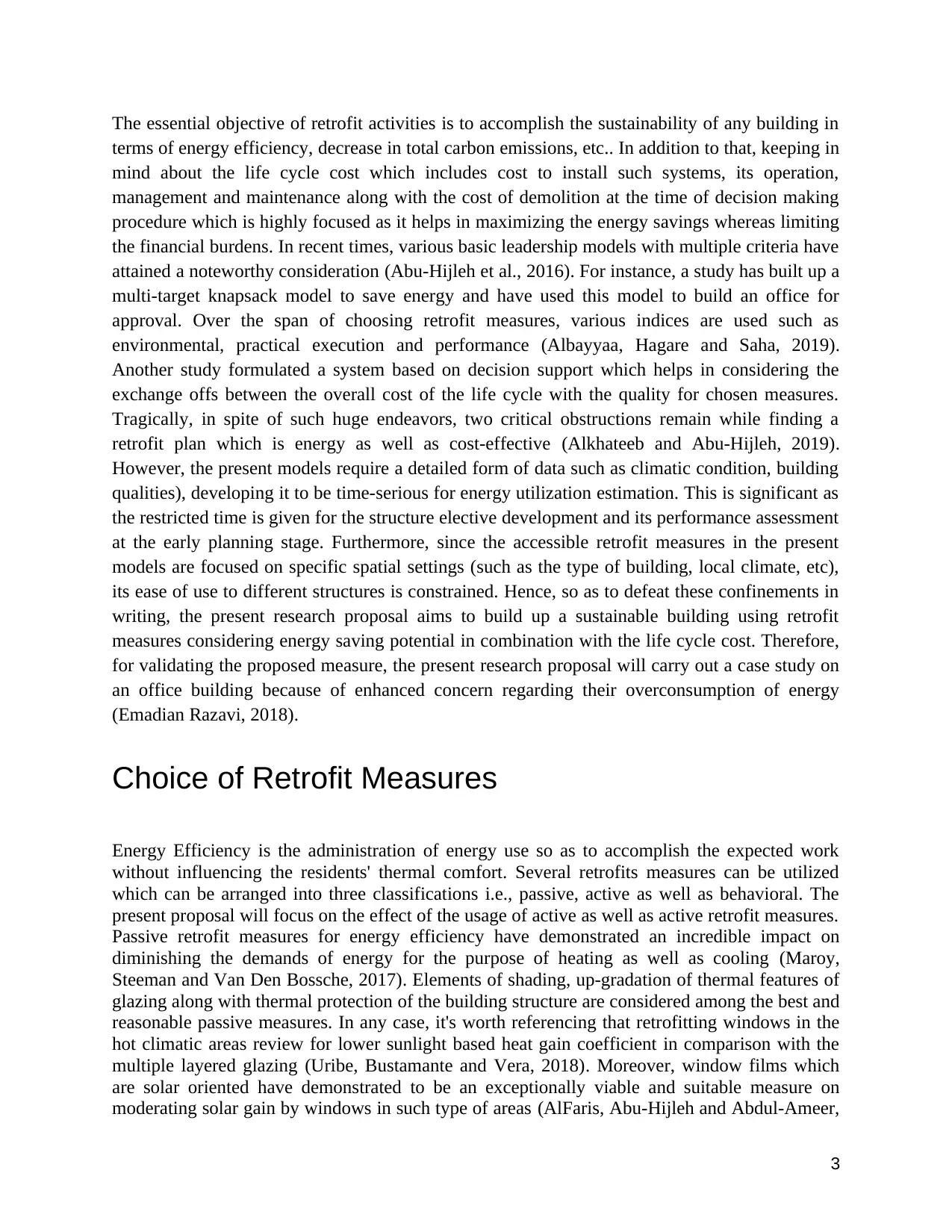
The essential objective of retrofit activities is to accomplish the sustainability of any building in
terms of energy efficiency, decrease in total carbon emissions, etc.. In addition to that, keeping in
mind about the life cycle cost which includes cost to install such systems, its operation,
management and maintenance along with the cost of demolition at the time of decision making
procedure which is highly focused as it helps in maximizing the energy savings whereas limiting
the financial burdens. In recent times, various basic leadership models with multiple criteria have
attained a noteworthy consideration (Abu-Hijleh et al., 2016). For instance, a study has built up a
multi-target knapsack model to save energy and have used this model to build an office for
approval. Over the span of choosing retrofit measures, various indices are used such as
environmental, practical execution and performance (Albayyaa, Hagare and Saha, 2019).
Another study formulated a system based on decision support which helps in considering the
exchange offs between the overall cost of the life cycle with the quality for chosen measures.
Tragically, in spite of such huge endeavors, two critical obstructions remain while finding a
retrofit plan which is energy as well as cost-effective (Alkhateeb and Abu-Hijleh, 2019).
However, the present models require a detailed form of data such as climatic condition, building
qualities), developing it to be time-serious for energy utilization estimation. This is significant as
the restricted time is given for the structure elective development and its performance assessment
at the early planning stage. Furthermore, since the accessible retrofit measures in the present
models are focused on specific spatial settings (such as the type of building, local climate, etc),
its ease of use to different structures is constrained. Hence, so as to defeat these confinements in
writing, the present research proposal aims to build up a sustainable building using retrofit
measures considering energy saving potential in combination with the life cycle cost. Therefore,
for validating the proposed measure, the present research proposal will carry out a case study on
an office building because of enhanced concern regarding their overconsumption of energy
(Emadian Razavi, 2018).
Choice of Retrofit Measures
Energy Efficiency is the administration of energy use so as to accomplish the expected work
without influencing the residents' thermal comfort. Several retrofits measures can be utilized
which can be arranged into three classifications i.e., passive, active as well as behavioral. The
present proposal will focus on the effect of the usage of active as well as active retrofit measures.
Passive retrofit measures for energy efficiency have demonstrated an incredible impact on
diminishing the demands of energy for the purpose of heating as well as cooling (Maroy,
Steeman and Van Den Bossche, 2017). Elements of shading, up-gradation of thermal features of
glazing along with thermal protection of the building structure are considered among the best and
reasonable passive measures. In any case, it's worth referencing that retrofitting windows in the
hot climatic areas review for lower sunlight based heat gain coefficient in comparison with the
multiple layered glazing (Uribe, Bustamante and Vera, 2018). Moreover, window films which
are solar oriented have demonstrated to be an exceptionally viable and suitable measure on
moderating solar gain by windows in such type of areas (AlFaris, Abu-Hijleh and Abdul-Ameer,
3
terms of energy efficiency, decrease in total carbon emissions, etc.. In addition to that, keeping in
mind about the life cycle cost which includes cost to install such systems, its operation,
management and maintenance along with the cost of demolition at the time of decision making
procedure which is highly focused as it helps in maximizing the energy savings whereas limiting
the financial burdens. In recent times, various basic leadership models with multiple criteria have
attained a noteworthy consideration (Abu-Hijleh et al., 2016). For instance, a study has built up a
multi-target knapsack model to save energy and have used this model to build an office for
approval. Over the span of choosing retrofit measures, various indices are used such as
environmental, practical execution and performance (Albayyaa, Hagare and Saha, 2019).
Another study formulated a system based on decision support which helps in considering the
exchange offs between the overall cost of the life cycle with the quality for chosen measures.
Tragically, in spite of such huge endeavors, two critical obstructions remain while finding a
retrofit plan which is energy as well as cost-effective (Alkhateeb and Abu-Hijleh, 2019).
However, the present models require a detailed form of data such as climatic condition, building
qualities), developing it to be time-serious for energy utilization estimation. This is significant as
the restricted time is given for the structure elective development and its performance assessment
at the early planning stage. Furthermore, since the accessible retrofit measures in the present
models are focused on specific spatial settings (such as the type of building, local climate, etc),
its ease of use to different structures is constrained. Hence, so as to defeat these confinements in
writing, the present research proposal aims to build up a sustainable building using retrofit
measures considering energy saving potential in combination with the life cycle cost. Therefore,
for validating the proposed measure, the present research proposal will carry out a case study on
an office building because of enhanced concern regarding their overconsumption of energy
(Emadian Razavi, 2018).
Choice of Retrofit Measures
Energy Efficiency is the administration of energy use so as to accomplish the expected work
without influencing the residents' thermal comfort. Several retrofits measures can be utilized
which can be arranged into three classifications i.e., passive, active as well as behavioral. The
present proposal will focus on the effect of the usage of active as well as active retrofit measures.
Passive retrofit measures for energy efficiency have demonstrated an incredible impact on
diminishing the demands of energy for the purpose of heating as well as cooling (Maroy,
Steeman and Van Den Bossche, 2017). Elements of shading, up-gradation of thermal features of
glazing along with thermal protection of the building structure are considered among the best and
reasonable passive measures. In any case, it's worth referencing that retrofitting windows in the
hot climatic areas review for lower sunlight based heat gain coefficient in comparison with the
multiple layered glazing (Uribe, Bustamante and Vera, 2018). Moreover, window films which
are solar oriented have demonstrated to be an exceptionally viable and suitable measure on
moderating solar gain by windows in such type of areas (AlFaris, Abu-Hijleh and Abdul-Ameer,
3
⊘ This is a preview!⊘
Do you want full access?
Subscribe today to unlock all pages.

Trusted by 1+ million students worldwide
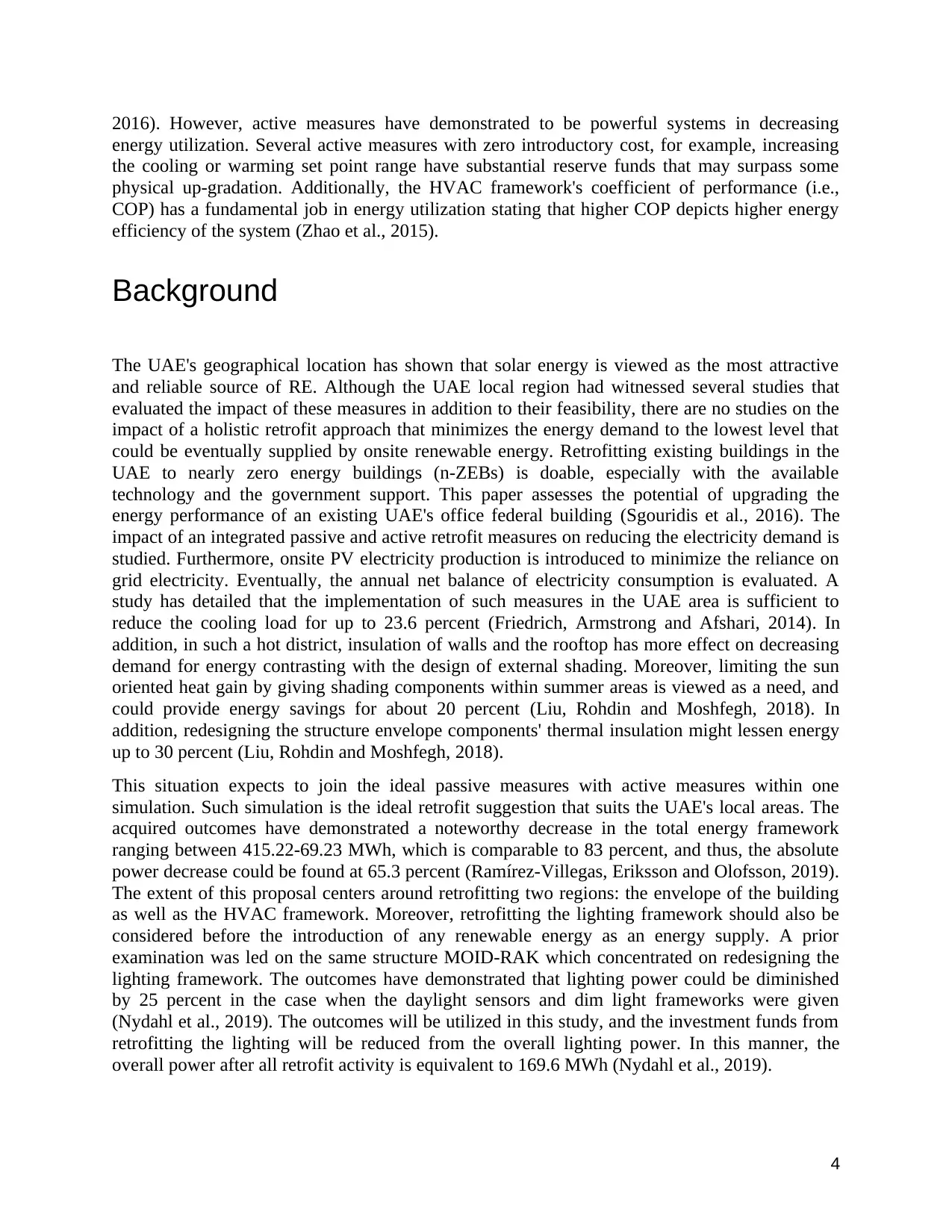
2016). However, active measures have demonstrated to be powerful systems in decreasing
energy utilization. Several active measures with zero introductory cost, for example, increasing
the cooling or warming set point range have substantial reserve funds that may surpass some
physical up-gradation. Additionally, the HVAC framework's coefficient of performance (i.e.,
COP) has a fundamental job in energy utilization stating that higher COP depicts higher energy
efficiency of the system (Zhao et al., 2015).
Background
The UAE's geographical location has shown that solar energy is viewed as the most attractive
and reliable source of RE. Although the UAE local region had witnessed several studies that
evaluated the impact of these measures in addition to their feasibility, there are no studies on the
impact of a holistic retrofit approach that minimizes the energy demand to the lowest level that
could be eventually supplied by onsite renewable energy. Retrofitting existing buildings in the
UAE to nearly zero energy buildings (n-ZEBs) is doable, especially with the available
technology and the government support. This paper assesses the potential of upgrading the
energy performance of an existing UAE's office federal building (Sgouridis et al., 2016). The
impact of an integrated passive and active retrofit measures on reducing the electricity demand is
studied. Furthermore, onsite PV electricity production is introduced to minimize the reliance on
grid electricity. Eventually, the annual net balance of electricity consumption is evaluated. A
study has detailed that the implementation of such measures in the UAE area is sufficient to
reduce the cooling load for up to 23.6 percent (Friedrich, Armstrong and Afshari, 2014). In
addition, in such a hot district, insulation of walls and the rooftop has more effect on decreasing
demand for energy contrasting with the design of external shading. Moreover, limiting the sun
oriented heat gain by giving shading components within summer areas is viewed as a need, and
could provide energy savings for about 20 percent (Liu, Rohdin and Moshfegh, 2018). In
addition, redesigning the structure envelope components' thermal insulation might lessen energy
up to 30 percent (Liu, Rohdin and Moshfegh, 2018).
This situation expects to join the ideal passive measures with active measures within one
simulation. Such simulation is the ideal retrofit suggestion that suits the UAE's local areas. The
acquired outcomes have demonstrated a noteworthy decrease in the total energy framework
ranging between 415.22-69.23 MWh, which is comparable to 83 percent, and thus, the absolute
power decrease could be found at 65.3 percent (Ramírez-Villegas, Eriksson and Olofsson, 2019).
The extent of this proposal centers around retrofitting two regions: the envelope of the building
as well as the HVAC framework. Moreover, retrofitting the lighting framework should also be
considered before the introduction of any renewable energy as an energy supply. A prior
examination was led on the same structure MOID-RAK which concentrated on redesigning the
lighting framework. The outcomes have demonstrated that lighting power could be diminished
by 25 percent in the case when the daylight sensors and dim light frameworks were given
(Nydahl et al., 2019). The outcomes will be utilized in this study, and the investment funds from
retrofitting the lighting will be reduced from the overall lighting power. In this manner, the
overall power after all retrofit activity is equivalent to 169.6 MWh (Nydahl et al., 2019).
4
energy utilization. Several active measures with zero introductory cost, for example, increasing
the cooling or warming set point range have substantial reserve funds that may surpass some
physical up-gradation. Additionally, the HVAC framework's coefficient of performance (i.e.,
COP) has a fundamental job in energy utilization stating that higher COP depicts higher energy
efficiency of the system (Zhao et al., 2015).
Background
The UAE's geographical location has shown that solar energy is viewed as the most attractive
and reliable source of RE. Although the UAE local region had witnessed several studies that
evaluated the impact of these measures in addition to their feasibility, there are no studies on the
impact of a holistic retrofit approach that minimizes the energy demand to the lowest level that
could be eventually supplied by onsite renewable energy. Retrofitting existing buildings in the
UAE to nearly zero energy buildings (n-ZEBs) is doable, especially with the available
technology and the government support. This paper assesses the potential of upgrading the
energy performance of an existing UAE's office federal building (Sgouridis et al., 2016). The
impact of an integrated passive and active retrofit measures on reducing the electricity demand is
studied. Furthermore, onsite PV electricity production is introduced to minimize the reliance on
grid electricity. Eventually, the annual net balance of electricity consumption is evaluated. A
study has detailed that the implementation of such measures in the UAE area is sufficient to
reduce the cooling load for up to 23.6 percent (Friedrich, Armstrong and Afshari, 2014). In
addition, in such a hot district, insulation of walls and the rooftop has more effect on decreasing
demand for energy contrasting with the design of external shading. Moreover, limiting the sun
oriented heat gain by giving shading components within summer areas is viewed as a need, and
could provide energy savings for about 20 percent (Liu, Rohdin and Moshfegh, 2018). In
addition, redesigning the structure envelope components' thermal insulation might lessen energy
up to 30 percent (Liu, Rohdin and Moshfegh, 2018).
This situation expects to join the ideal passive measures with active measures within one
simulation. Such simulation is the ideal retrofit suggestion that suits the UAE's local areas. The
acquired outcomes have demonstrated a noteworthy decrease in the total energy framework
ranging between 415.22-69.23 MWh, which is comparable to 83 percent, and thus, the absolute
power decrease could be found at 65.3 percent (Ramírez-Villegas, Eriksson and Olofsson, 2019).
The extent of this proposal centers around retrofitting two regions: the envelope of the building
as well as the HVAC framework. Moreover, retrofitting the lighting framework should also be
considered before the introduction of any renewable energy as an energy supply. A prior
examination was led on the same structure MOID-RAK which concentrated on redesigning the
lighting framework. The outcomes have demonstrated that lighting power could be diminished
by 25 percent in the case when the daylight sensors and dim light frameworks were given
(Nydahl et al., 2019). The outcomes will be utilized in this study, and the investment funds from
retrofitting the lighting will be reduced from the overall lighting power. In this manner, the
overall power after all retrofit activity is equivalent to 169.6 MWh (Nydahl et al., 2019).
4
Paraphrase This Document
Need a fresh take? Get an instant paraphrase of this document with our AI Paraphraser
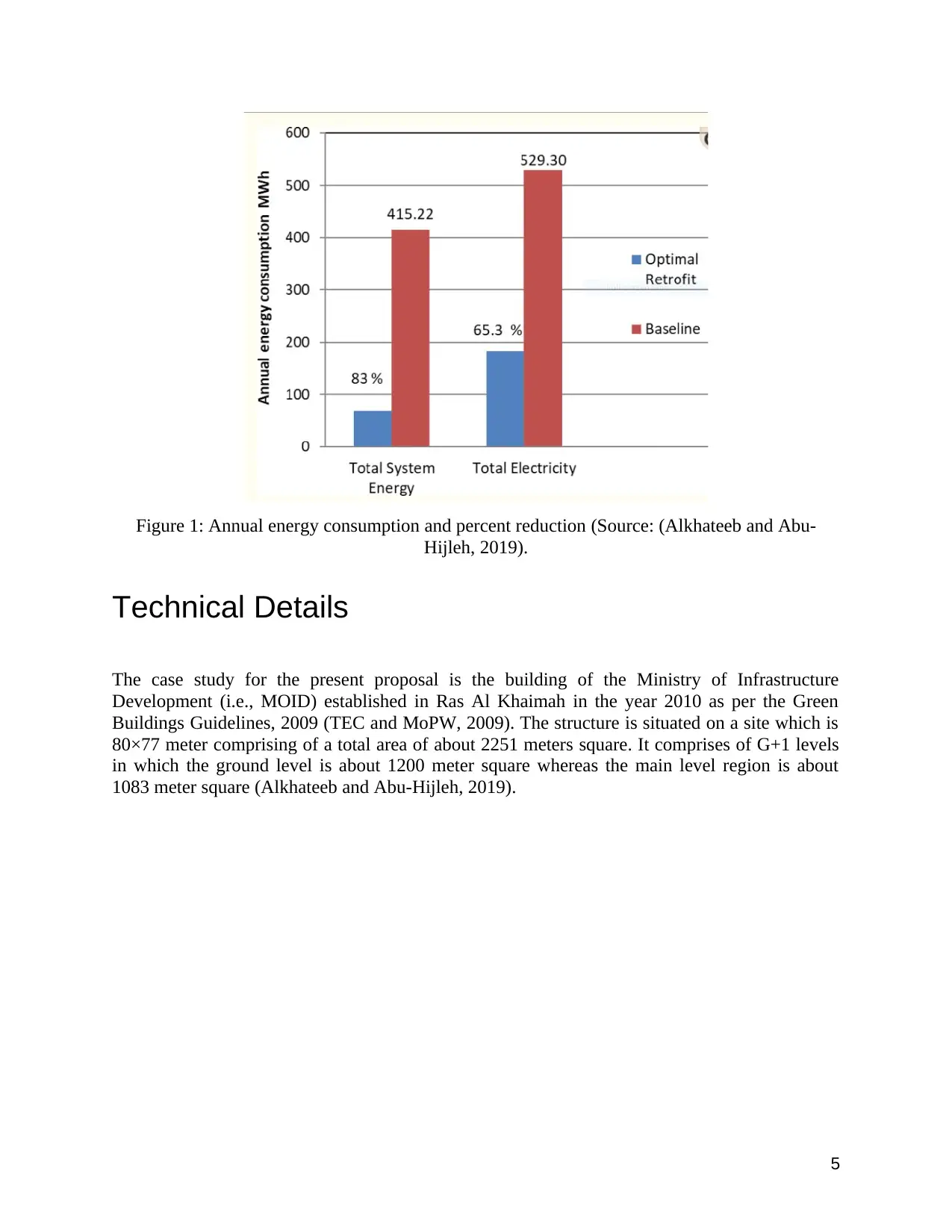
Figure 1: Annual energy consumption and percent reduction (Source: (Alkhateeb and Abu-
Hijleh, 2019).
Technical Details
The case study for the present proposal is the building of the Ministry of Infrastructure
Development (i.e., MOID) established in Ras Al Khaimah in the year 2010 as per the Green
Buildings Guidelines, 2009 (TEC and MoPW, 2009). The structure is situated on a site which is
80×77 meter comprising of a total area of about 2251 meters square. It comprises of G+1 levels
in which the ground level is about 1200 meter square whereas the main level region is about
1083 meter square (Alkhateeb and Abu-Hijleh, 2019).
5
Hijleh, 2019).
Technical Details
The case study for the present proposal is the building of the Ministry of Infrastructure
Development (i.e., MOID) established in Ras Al Khaimah in the year 2010 as per the Green
Buildings Guidelines, 2009 (TEC and MoPW, 2009). The structure is situated on a site which is
80×77 meter comprising of a total area of about 2251 meters square. It comprises of G+1 levels
in which the ground level is about 1200 meter square whereas the main level region is about
1083 meter square (Alkhateeb and Abu-Hijleh, 2019).
5
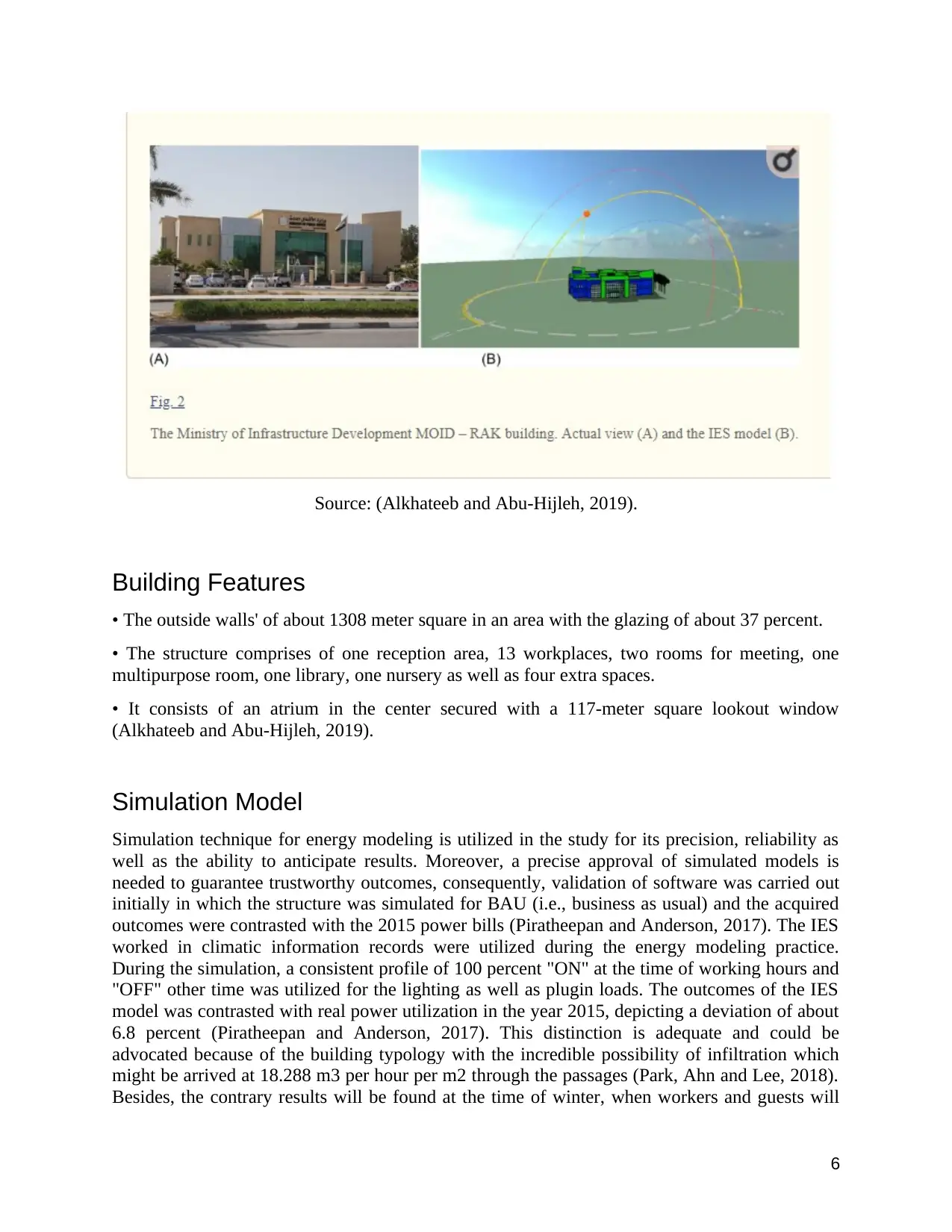
Source: (Alkhateeb and Abu-Hijleh, 2019).
Building Features
• The outside walls' of about 1308 meter square in an area with the glazing of about 37 percent.
• The structure comprises of one reception area, 13 workplaces, two rooms for meeting, one
multipurpose room, one library, one nursery as well as four extra spaces.
• It consists of an atrium in the center secured with a 117-meter square lookout window
(Alkhateeb and Abu-Hijleh, 2019).
Simulation Model
Simulation technique for energy modeling is utilized in the study for its precision, reliability as
well as the ability to anticipate results. Moreover, a precise approval of simulated models is
needed to guarantee trustworthy outcomes, consequently, validation of software was carried out
initially in which the structure was simulated for BAU (i.e., business as usual) and the acquired
outcomes were contrasted with the 2015 power bills (Piratheepan and Anderson, 2017). The IES
worked in climatic information records were utilized during the energy modeling practice.
During the simulation, a consistent profile of 100 percent "ON" at the time of working hours and
"OFF" other time was utilized for the lighting as well as plugin loads. The outcomes of the IES
model was contrasted with real power utilization in the year 2015, depicting a deviation of about
6.8 percent (Piratheepan and Anderson, 2017). This distinction is adequate and could be
advocated because of the building typology with the incredible possibility of infiltration which
might be arrived at 18.288 m3 per hour per m2 through the passages (Park, Ahn and Lee, 2018).
Besides, the contrary results will be found at the time of winter, when workers and guests will
6
Building Features
• The outside walls' of about 1308 meter square in an area with the glazing of about 37 percent.
• The structure comprises of one reception area, 13 workplaces, two rooms for meeting, one
multipurpose room, one library, one nursery as well as four extra spaces.
• It consists of an atrium in the center secured with a 117-meter square lookout window
(Alkhateeb and Abu-Hijleh, 2019).
Simulation Model
Simulation technique for energy modeling is utilized in the study for its precision, reliability as
well as the ability to anticipate results. Moreover, a precise approval of simulated models is
needed to guarantee trustworthy outcomes, consequently, validation of software was carried out
initially in which the structure was simulated for BAU (i.e., business as usual) and the acquired
outcomes were contrasted with the 2015 power bills (Piratheepan and Anderson, 2017). The IES
worked in climatic information records were utilized during the energy modeling practice.
During the simulation, a consistent profile of 100 percent "ON" at the time of working hours and
"OFF" other time was utilized for the lighting as well as plugin loads. The outcomes of the IES
model was contrasted with real power utilization in the year 2015, depicting a deviation of about
6.8 percent (Piratheepan and Anderson, 2017). This distinction is adequate and could be
advocated because of the building typology with the incredible possibility of infiltration which
might be arrived at 18.288 m3 per hour per m2 through the passages (Park, Ahn and Lee, 2018).
Besides, the contrary results will be found at the time of winter, when workers and guests will
6
⊘ This is a preview!⊘
Do you want full access?
Subscribe today to unlock all pages.

Trusted by 1+ million students worldwide
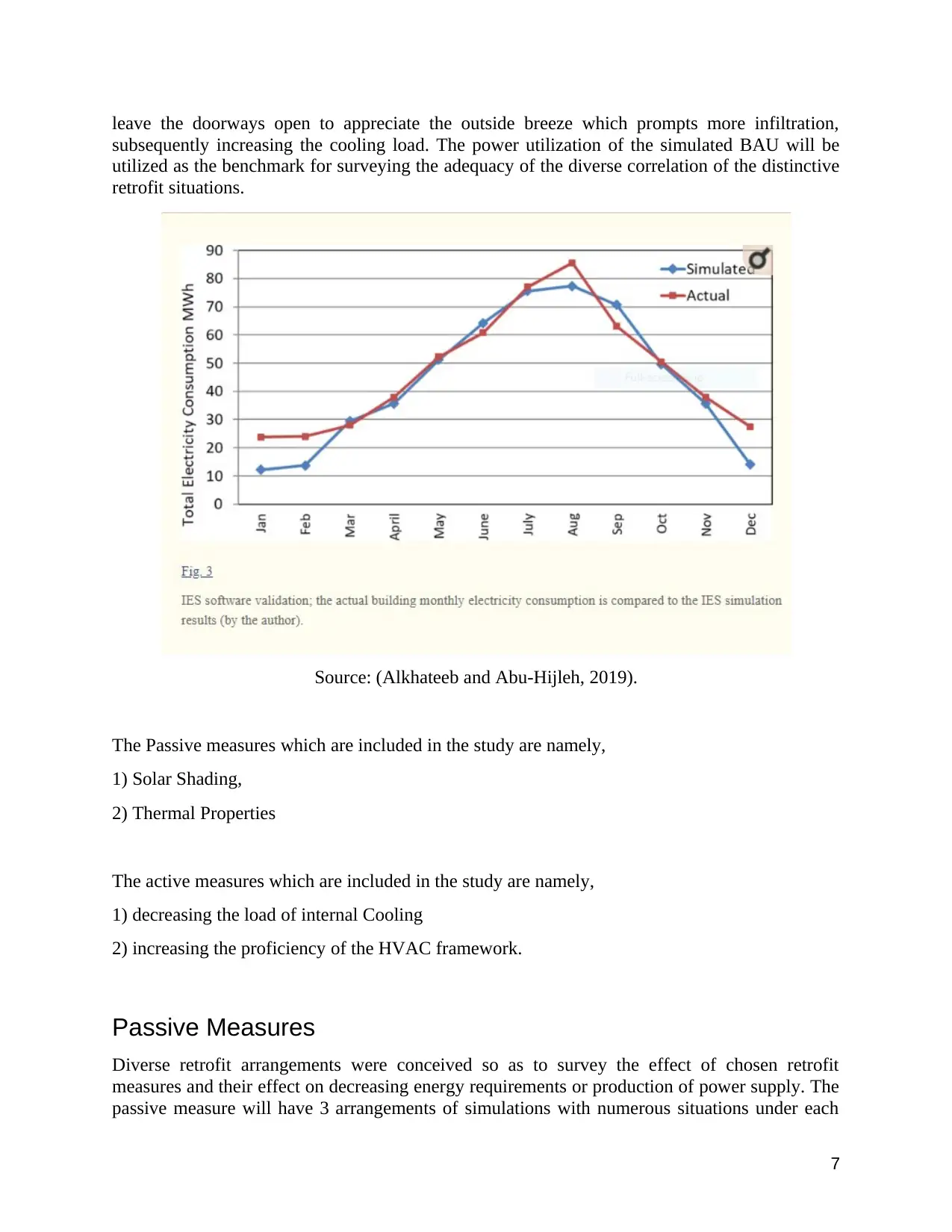
leave the doorways open to appreciate the outside breeze which prompts more infiltration,
subsequently increasing the cooling load. The power utilization of the simulated BAU will be
utilized as the benchmark for surveying the adequacy of the diverse correlation of the distinctive
retrofit situations.
Source: (Alkhateeb and Abu-Hijleh, 2019).
The Passive measures which are included in the study are namely,
1) Solar Shading,
2) Thermal Properties
The active measures which are included in the study are namely,
1) decreasing the load of internal Cooling
2) increasing the proficiency of the HVAC framework.
Passive Measures
Diverse retrofit arrangements were conceived so as to survey the effect of chosen retrofit
measures and their effect on decreasing energy requirements or production of power supply. The
passive measure will have 3 arrangements of simulations with numerous situations under each
7
subsequently increasing the cooling load. The power utilization of the simulated BAU will be
utilized as the benchmark for surveying the adequacy of the diverse correlation of the distinctive
retrofit situations.
Source: (Alkhateeb and Abu-Hijleh, 2019).
The Passive measures which are included in the study are namely,
1) Solar Shading,
2) Thermal Properties
The active measures which are included in the study are namely,
1) decreasing the load of internal Cooling
2) increasing the proficiency of the HVAC framework.
Passive Measures
Diverse retrofit arrangements were conceived so as to survey the effect of chosen retrofit
measures and their effect on decreasing energy requirements or production of power supply. The
passive measure will have 3 arrangements of simulations with numerous situations under each
7
Paraphrase This Document
Need a fresh take? Get an instant paraphrase of this document with our AI Paraphraser
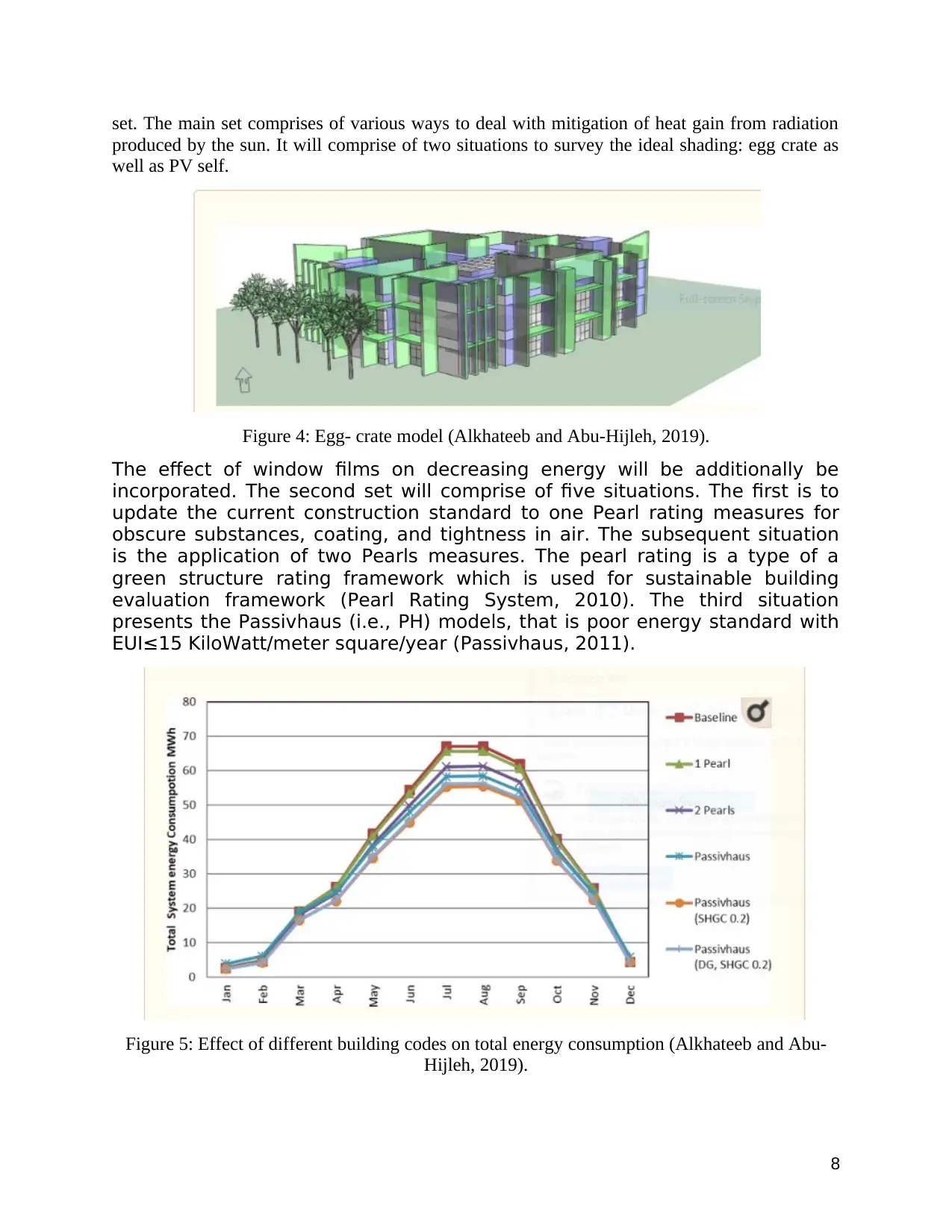
set. The main set comprises of various ways to deal with mitigation of heat gain from radiation
produced by the sun. It will comprise of two situations to survey the ideal shading: egg crate as
well as PV self.
Figure 4: Egg- crate model (Alkhateeb and Abu-Hijleh, 2019).
The effect of window films on decreasing energy will be additionally be
incorporated. The second set will comprise of five situations. The first is to
update the current construction standard to one Pearl rating measures for
obscure substances, coating, and tightness in air. The subsequent situation
is the application of two Pearls measures. The pearl rating is a type of a
green structure rating framework which is used for sustainable building
evaluation framework (Pearl Rating System, 2010). The third situation
presents the Passivhaus (i.e., PH) models, that is poor energy standard with
EUI≤15 KiloWatt/meter square/year (Passivhaus, 2011).
Figure 5: Effect of different building codes on total energy consumption (Alkhateeb and Abu-
Hijleh, 2019).
8
produced by the sun. It will comprise of two situations to survey the ideal shading: egg crate as
well as PV self.
Figure 4: Egg- crate model (Alkhateeb and Abu-Hijleh, 2019).
The effect of window films on decreasing energy will be additionally be
incorporated. The second set will comprise of five situations. The first is to
update the current construction standard to one Pearl rating measures for
obscure substances, coating, and tightness in air. The subsequent situation
is the application of two Pearls measures. The pearl rating is a type of a
green structure rating framework which is used for sustainable building
evaluation framework (Pearl Rating System, 2010). The third situation
presents the Passivhaus (i.e., PH) models, that is poor energy standard with
EUI≤15 KiloWatt/meter square/year (Passivhaus, 2011).
Figure 5: Effect of different building codes on total energy consumption (Alkhateeb and Abu-
Hijleh, 2019).
8
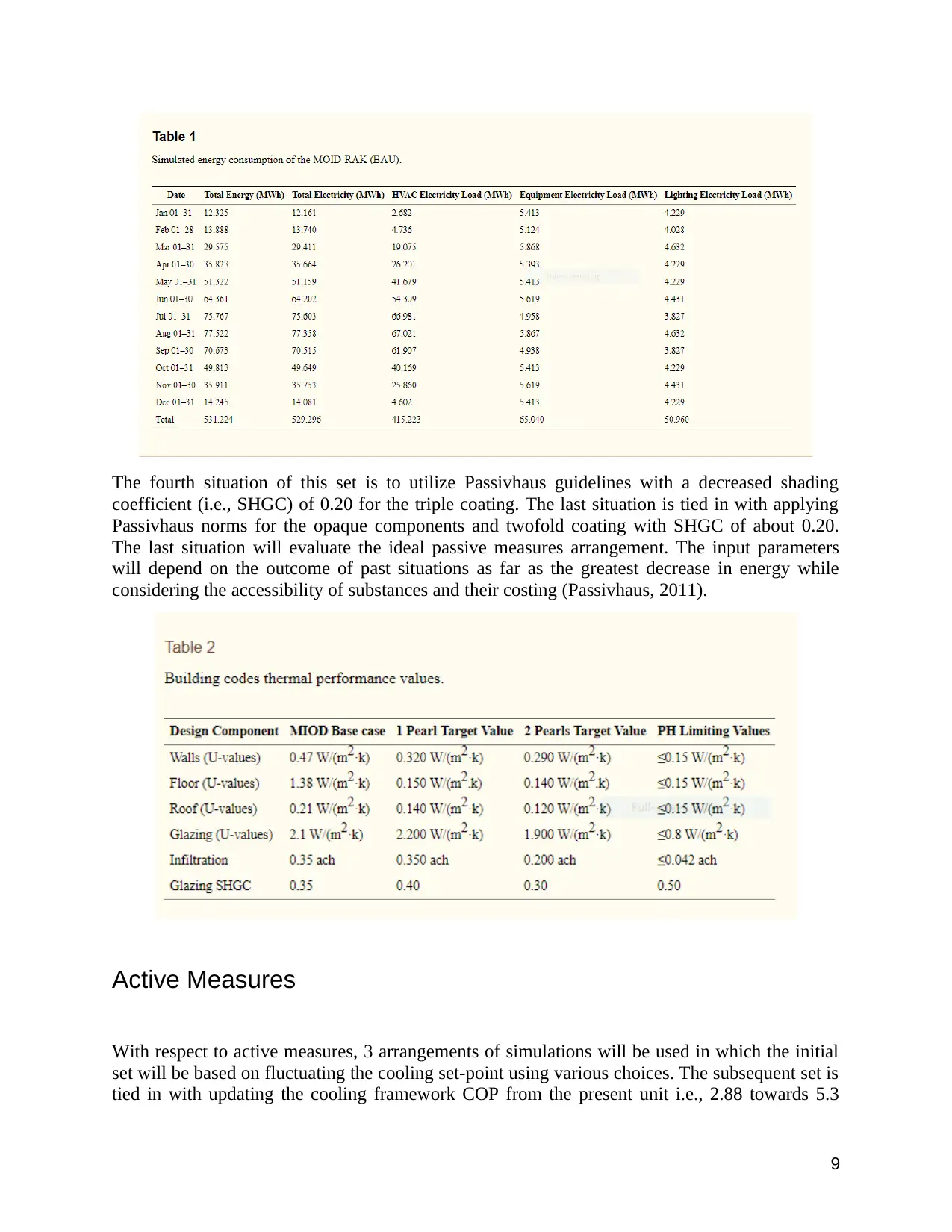
The fourth situation of this set is to utilize Passivhaus guidelines with a decreased shading
coefficient (i.e., SHGC) of 0.20 for the triple coating. The last situation is tied in with applying
Passivhaus norms for the opaque components and twofold coating with SHGC of about 0.20.
The last situation will evaluate the ideal passive measures arrangement. The input parameters
will depend on the outcome of past situations as far as the greatest decrease in energy while
considering the accessibility of substances and their costing (Passivhaus, 2011).
Active Measures
With respect to active measures, 3 arrangements of simulations will be used in which the initial
set will be based on fluctuating the cooling set-point using various choices. The subsequent set is
tied in with updating the cooling framework COP from the present unit i.e., 2.88 towards 5.3
9
coefficient (i.e., SHGC) of 0.20 for the triple coating. The last situation is tied in with applying
Passivhaus norms for the opaque components and twofold coating with SHGC of about 0.20.
The last situation will evaluate the ideal passive measures arrangement. The input parameters
will depend on the outcome of past situations as far as the greatest decrease in energy while
considering the accessibility of substances and their costing (Passivhaus, 2011).
Active Measures
With respect to active measures, 3 arrangements of simulations will be used in which the initial
set will be based on fluctuating the cooling set-point using various choices. The subsequent set is
tied in with updating the cooling framework COP from the present unit i.e., 2.88 towards 5.3
9
⊘ This is a preview!⊘
Do you want full access?
Subscribe today to unlock all pages.

Trusted by 1+ million students worldwide

representing the mean of the latest efficient frameworks offering about 30 percent of energy
savings (Jensen and Maslesa, 2015). The third arrangement will provide an ideal active situation
that consolidates the best outcomes of varied set point as well as COP. The last ideal retrofit
model will comprise of both ideal passive and active measures in one situation. The acquired
outcome will be broken down and the electrical energy will be counterbalanced by PV power
generation. The last simulation set will introduce different situations that survey the energy
supply options. Distinctive PV installing methodologies are considered (total and ideal), along
with diverse PV innovations (mono/poly-crystalline) with the highest efficiency (Jensen and
Maslesa, 2015).
Figure 6: PV panels (Alkhateeb and Abu-Hijleh, 2019).
Maintenance and Management Issues
From the contextual investigation, it was discovered that the proposed measures produce a
retrofit plan which is highly cost-effective for the building. The upgraded measures would be
relied upon to amplify energy savings while limiting the overall life cycle cost. Also, it appears
that such advantages will increment through incorporating the proposed model with heating,
ventilation and cooling (HVAC) framework control. HVAC frameworks represent roughly half
of building energy utilization (Song et al., 2017). The HVAC framework control (i.e.,
modification of temperature setpoint) adds to decreasing building energy utilization up to 33.6
percent which is against the reference time frame (Yang, Yan and Lam, 2014). Especially,
HVAC framework control has a high similarity with different simulation models. In this way,
utilizing HVAC framework control would give extra energy-saving despite the fact that an
enhanced retrofit plan is being recognized. The real power utilization for the year 2015 was
around 568.4 MWh hence, depicting an energy intensity (i.e., IE) of about 252.5 kWh/m2/year
which is a moderately high worth contrasted with an EI of about 110 kWh/m2/yr to 170
kWh/m2/year for the best practice structures in the UAE (Alkhateeb and Abu-Hijleh, 2019). So
as to mention the primary source behind this high power requirements, the base case energy
10
savings (Jensen and Maslesa, 2015). The third arrangement will provide an ideal active situation
that consolidates the best outcomes of varied set point as well as COP. The last ideal retrofit
model will comprise of both ideal passive and active measures in one situation. The acquired
outcome will be broken down and the electrical energy will be counterbalanced by PV power
generation. The last simulation set will introduce different situations that survey the energy
supply options. Distinctive PV installing methodologies are considered (total and ideal), along
with diverse PV innovations (mono/poly-crystalline) with the highest efficiency (Jensen and
Maslesa, 2015).
Figure 6: PV panels (Alkhateeb and Abu-Hijleh, 2019).
Maintenance and Management Issues
From the contextual investigation, it was discovered that the proposed measures produce a
retrofit plan which is highly cost-effective for the building. The upgraded measures would be
relied upon to amplify energy savings while limiting the overall life cycle cost. Also, it appears
that such advantages will increment through incorporating the proposed model with heating,
ventilation and cooling (HVAC) framework control. HVAC frameworks represent roughly half
of building energy utilization (Song et al., 2017). The HVAC framework control (i.e.,
modification of temperature setpoint) adds to decreasing building energy utilization up to 33.6
percent which is against the reference time frame (Yang, Yan and Lam, 2014). Especially,
HVAC framework control has a high similarity with different simulation models. In this way,
utilizing HVAC framework control would give extra energy-saving despite the fact that an
enhanced retrofit plan is being recognized. The real power utilization for the year 2015 was
around 568.4 MWh hence, depicting an energy intensity (i.e., IE) of about 252.5 kWh/m2/year
which is a moderately high worth contrasted with an EI of about 110 kWh/m2/yr to 170
kWh/m2/year for the best practice structures in the UAE (Alkhateeb and Abu-Hijleh, 2019). So
as to mention the primary source behind this high power requirements, the base case energy
10
Paraphrase This Document
Need a fresh take? Get an instant paraphrase of this document with our AI Paraphraser
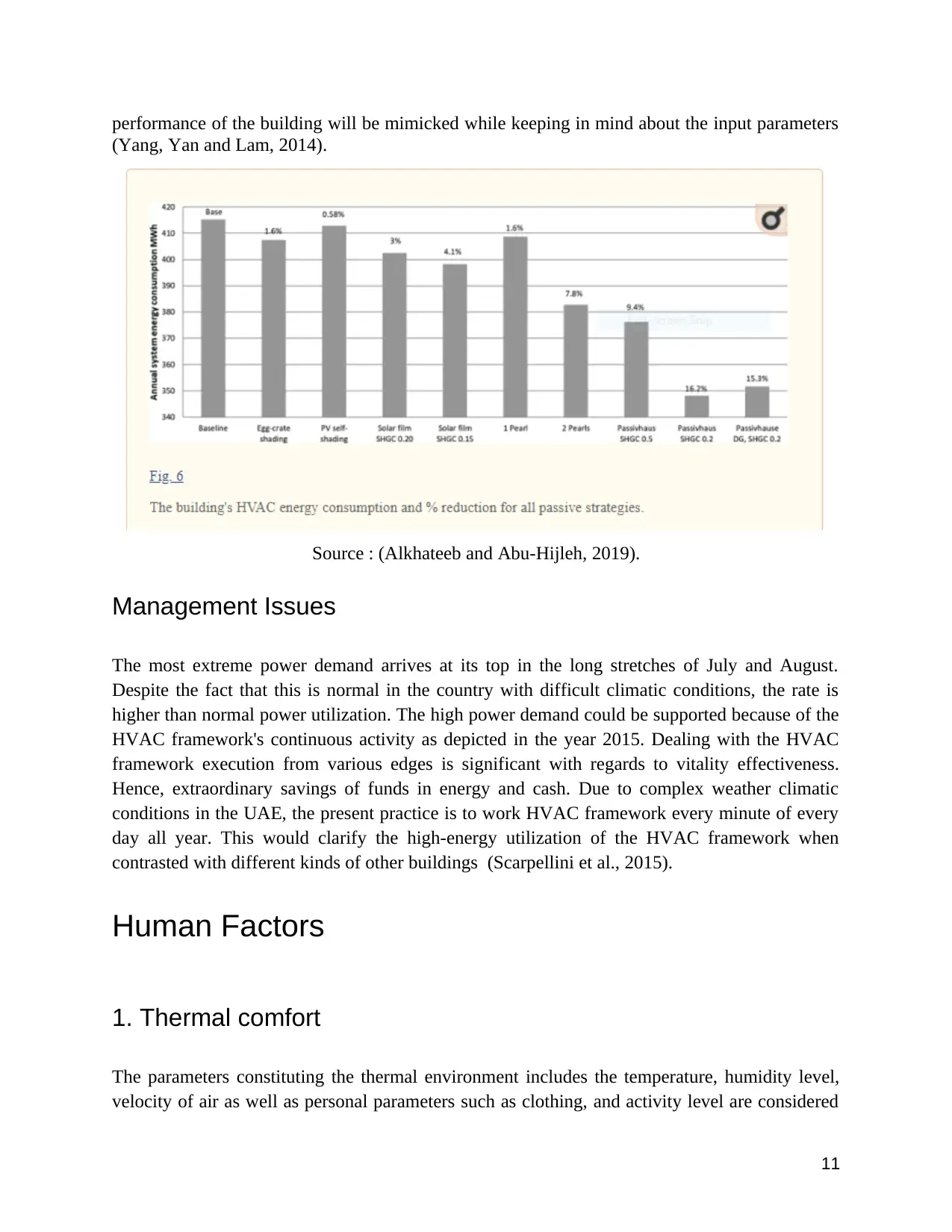
performance of the building will be mimicked while keeping in mind about the input parameters
(Yang, Yan and Lam, 2014).
Source : (Alkhateeb and Abu-Hijleh, 2019).
Management Issues
The most extreme power demand arrives at its top in the long stretches of July and August.
Despite the fact that this is normal in the country with difficult climatic conditions, the rate is
higher than normal power utilization. The high power demand could be supported because of the
HVAC framework's continuous activity as depicted in the year 2015. Dealing with the HVAC
framework execution from various edges is significant with regards to vitality effectiveness.
Hence, extraordinary savings of funds in energy and cash. Due to complex weather climatic
conditions in the UAE, the present practice is to work HVAC framework every minute of every
day all year. This would clarify the high-energy utilization of the HVAC framework when
contrasted with different kinds of other buildings (Scarpellini et al., 2015).
Human Factors
1. Thermal comfort
The parameters constituting the thermal environment includes the temperature, humidity level,
velocity of air as well as personal parameters such as clothing, and activity level are considered
11
(Yang, Yan and Lam, 2014).
Source : (Alkhateeb and Abu-Hijleh, 2019).
Management Issues
The most extreme power demand arrives at its top in the long stretches of July and August.
Despite the fact that this is normal in the country with difficult climatic conditions, the rate is
higher than normal power utilization. The high power demand could be supported because of the
HVAC framework's continuous activity as depicted in the year 2015. Dealing with the HVAC
framework execution from various edges is significant with regards to vitality effectiveness.
Hence, extraordinary savings of funds in energy and cash. Due to complex weather climatic
conditions in the UAE, the present practice is to work HVAC framework every minute of every
day all year. This would clarify the high-energy utilization of the HVAC framework when
contrasted with different kinds of other buildings (Scarpellini et al., 2015).
Human Factors
1. Thermal comfort
The parameters constituting the thermal environment includes the temperature, humidity level,
velocity of air as well as personal parameters such as clothing, and activity level are considered
11
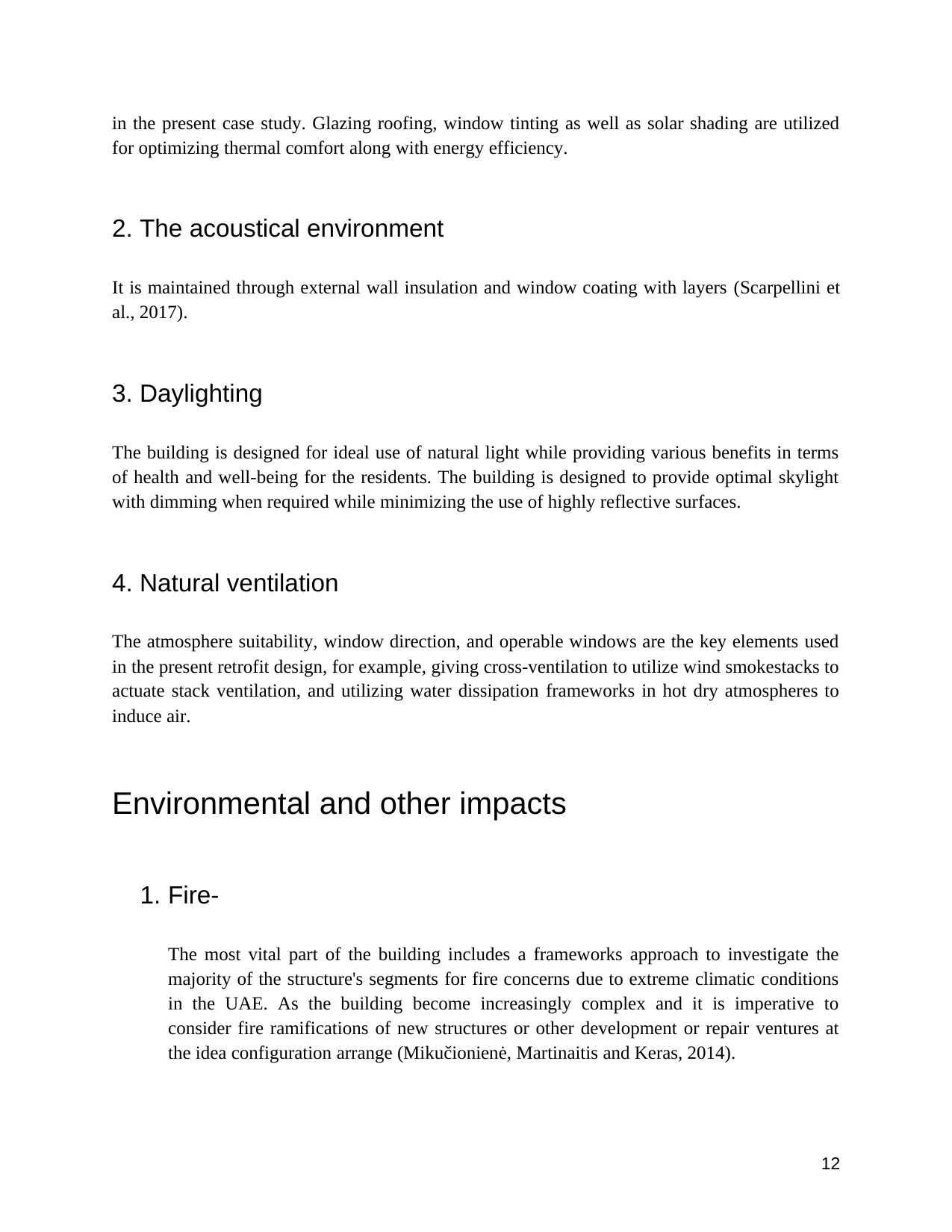
in the present case study. Glazing roofing, window tinting as well as solar shading are utilized
for optimizing thermal comfort along with energy efficiency.
2. The acoustical environment
It is maintained through external wall insulation and window coating with layers (Scarpellini et
al., 2017).
3. Daylighting
The building is designed for ideal use of natural light while providing various benefits in terms
of health and well-being for the residents. The building is designed to provide optimal skylight
with dimming when required while minimizing the use of highly reflective surfaces.
4. Natural ventilation
The atmosphere suitability, window direction, and operable windows are the key elements used
in the present retrofit design, for example, giving cross-ventilation to utilize wind smokestacks to
actuate stack ventilation, and utilizing water dissipation frameworks in hot dry atmospheres to
induce air.
Environmental and other impacts
1. Fire-
The most vital part of the building includes a frameworks approach to investigate the
majority of the structure's segments for fire concerns due to extreme climatic conditions
in the UAE. As the building become increasingly complex and it is imperative to
consider fire ramifications of new structures or other development or repair ventures at
the idea configuration arrange (Mikučionienė, Martinaitis and Keras, 2014).
12
for optimizing thermal comfort along with energy efficiency.
2. The acoustical environment
It is maintained through external wall insulation and window coating with layers (Scarpellini et
al., 2017).
3. Daylighting
The building is designed for ideal use of natural light while providing various benefits in terms
of health and well-being for the residents. The building is designed to provide optimal skylight
with dimming when required while minimizing the use of highly reflective surfaces.
4. Natural ventilation
The atmosphere suitability, window direction, and operable windows are the key elements used
in the present retrofit design, for example, giving cross-ventilation to utilize wind smokestacks to
actuate stack ventilation, and utilizing water dissipation frameworks in hot dry atmospheres to
induce air.
Environmental and other impacts
1. Fire-
The most vital part of the building includes a frameworks approach to investigate the
majority of the structure's segments for fire concerns due to extreme climatic conditions
in the UAE. As the building become increasingly complex and it is imperative to
consider fire ramifications of new structures or other development or repair ventures at
the idea configuration arrange (Mikučionienė, Martinaitis and Keras, 2014).
12
⊘ This is a preview!⊘
Do you want full access?
Subscribe today to unlock all pages.

Trusted by 1+ million students worldwide
1 out of 17
Related Documents
Your All-in-One AI-Powered Toolkit for Academic Success.
+13062052269
info@desklib.com
Available 24*7 on WhatsApp / Email
![[object Object]](/_next/static/media/star-bottom.7253800d.svg)
Unlock your academic potential
Copyright © 2020–2025 A2Z Services. All Rights Reserved. Developed and managed by ZUCOL.





